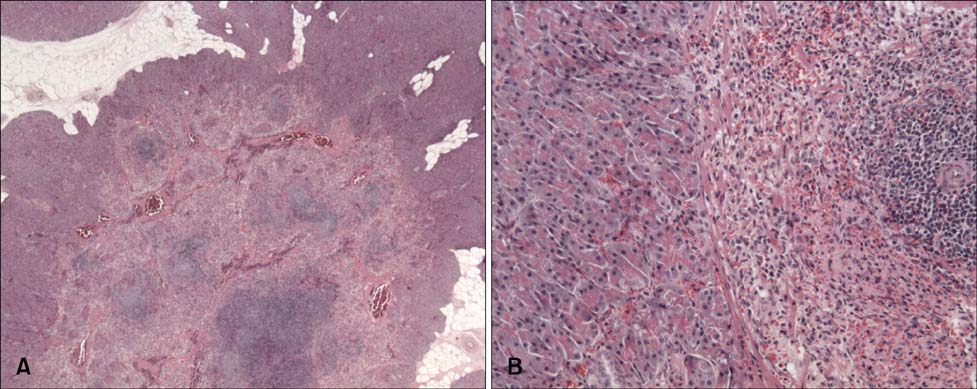J Vet Sci.
2015 Jun;16(2):241-244. 10.4142/jvs.2015.16.2.241.
Intrapancreatic ectopic splenic tissue found in a cloned miniature pig
- Affiliations
-
- 1Laboratory Animal Research Center, Samsung Biomedical Research Institute, Suwon 440-746, Korea.
- 2National Institute on Alcohol Abuse and Alcoholism, National Institutes of Health, Bethesda, MD 20892-9410, USA.
- 3Department of Theriogenology and Biotechnology, College of Veterinary Medicine, Seoul National University, Seoul 151-742, Korea. bclee@snu.ac.kr
- KMID: 2164536
- DOI: http://doi.org/10.4142/jvs.2015.16.2.241
Abstract
- Somatic cell nuclear transfer (SCNT) is a cost-effective technique for producing transgenic pigs. However, abnormalities in the cloned pigs might prevent use these animals for clinical applications or disease modeling. In the present study, we generated several cloned pigs. One of the pigs was found to have intrapancreatic ectopic splenic tissue during histopathology analysis although this animal was grossly normal and genetically identical to the other cloned pigs. Ectopic splenic tissue in the pancreas is very rare, especially in animals. To the best of our knowledge, this is the first such report for cloned pigs.
MeSH Terms
Figure
Reference
-
1. Arkadopoulos N, Athanasopoulos P, Stafyla V, Karakatsanis A, Koutoulidis V, Theodosopoulos T, Karvouni E, Smyrniotis V. Intrapancreatic accessory spleen issues: diagnostic and therapeutic challenges. JOP. 2009; 10:400–405.2. Bundza A, Dukes TW. Some heterotopic tissue remnants in domestic animals. Can Vet J. 1978; 19:322–324.3. Cho B, Koo OJ, Hwang JI, Kim H, Lee EM, Hurh S, Park SJ, Ro H, Yang J, Surh CD, D'Apice AJ, Lee BC, Ahn C. Generation of soluble human tumor necrosis factor-α receptor 1-Fc transgenic pig. Transplantation. 2011; 92:139–147.
Article4. Cho SK, Kim JH, Park JY, Choi YJ, Bang JI, Hwang KC, Cho EJ, Sohn SH, Uhm SJ, Koo DB, Lee KK, Kim T, Kim JH. Serial cloning of pigs by somatic cell nuclear transfer: restoration of phenotypic normality during serial cloning. Dev Dyn. 2007; 236:3369–3382.
Article5. Cibelli JB, Campbell KH, Seidel GE, West MD, Lanza RP. The health profile of cloned animals. Nat Biotechnol. 2002; 20:13–14.
Article6. Galli C, Perota A, Brunetti D, Lagutina I, Lazzari G, Lucchini F. Genetic engineering including superseding microinjection: new ways to make GM pigs. Xenotransplantation. 2010; 17:397–410.
Article7. Lee GS, Kim HS, Lee SH, Kim DY, Seo KM, Hyun SH, Kang SK, Lee BC, Hwang WS. Successful surgical correction of anal atresia in a transgenic cloned piglet. J Vet Sci. 2005; 6:243–245.
Article8. Ramírez GA, Altimira J, García-González B, Vilafranca M. Intrapancreatic ectopic splenic tissue in dogs and cats. J Comp Pathol. 2013; 148:361–364.
Article
- Full Text Links
- Actions
-
Cited
- CITED
-
- Close
- Share
- Similar articles
-
- Successful surgical correction of anal atresia in a transgenic cloned piglet
- Accessory Splenic Infarction Presenting as a Hemorrhagic Tumor in the Pancreas
- No Evidence of the Productive Replication of Porcine Endogenous Retrovirus (PERV) from SNU Miniature Pigs in Human Cell Line
- An epidermoid cyst in an intrapancreatic accessory spleen
- Ectopic Mediastinal Thyroid Successfully Removed by Surgical Excision via Transcervical Approach


